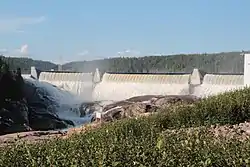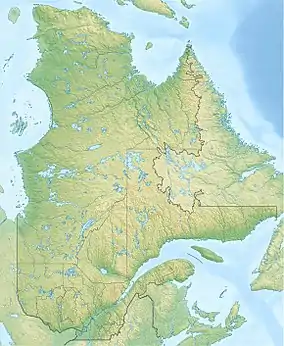Magpie River (Quebec)
The Magpie River (French: Rivière Magpie) is a 200 kilometres (120 mi) river in the Côte-Nord region of Quebec which flows from the Labrador Plateau to empty into the north shore of the Saint Lawrence River east of Sept-Îles, Quebec.
| Magpie River Rivière Magpie | |
|---|---|
 Magpie dam | |
 | |
| Native name | Mutehekau Hipu (Innu) |
| Location | |
| Country | Canada |
| Province | Quebec |
| Region | Côte-Nord |
| RCM | Minganie, Sept-Rivières |
| Physical characteristics | |
| Mouth | Gulf of Saint Lawrence |
• coordinates | |
• elevation | 0 metres (0 ft) |
| Length | 200 kilometres (120 mi) |
| Basin size | 7,646 square kilometres (2,952 sq mi) |
Location
The Magpie River is 200 kilometres (120 mi) long. It rises near the border between Quebec and Labrador, flows south, and enters Magpie Bay on the Gulf of Saint Lawrence 60 kilometres (37 mi) west of Havre-Saint-Pierre. Two of its tributaries are named Magpie West and Magpie East. The central section contains the long Lake Magpie The river is not wide, but fast and turbulent.
Its estuary is wide and forms a harbour for fishing boats. The village of Magpie is on the hillside around another small harbor on Magpie Bay 3 kilometres (1.9 mi) west of the river mouth, and is one of the oldest towns on the Côte-Nord. The site was visited from 1849 by Gaspesians from Chaleur Bay who came to fish for cod and Atlantic salmon. The village boomed after the fishing companies Robin & Colas and Le Bouthillier establish facilities there around 1870.[1]
Name
The river is named for the Canada jay (Perisoreus canadensis), which the English called "magpie". In the 19th century the local people pronounced in Magpointe. In 1870 Eugène-Étienne Taché's map showed the river as "R. Magpie or La Pie". In 1886 the surveyor Saint-Cyr called it Rivière à la Pie. It is nicknamed La Pie. According to the Abbé Victor-Alphonse Huard, it was also called Girard River after the three Girard brothers who settled in the area around 1849. The Innu have called it by various names, including Moteskikan Hipu, meaning "abrupt", "rocky" or "difficult" river, Mutehekau Hipu which translates as "river where the water passes between the square rocky cliffs" and Pmotewsekaw Sipo which means "river along which one walks among the shrubs".[1]
Description
According to the Dictionnaire des rivières et lacs de la province de Québec (1914),
On the north coast of the Saint Lawrence, Saguenay County, at 380 miles from Quebec and six miles east of Ouapitagon. This watercourse is quite difficult to navigate, since it is broken by a series of falls and rapids from its mouth to a distance of about thirty four miles upstream. At this distance there is a very deep lake, 53 miles long. At 8 miles from the mouth there is a stand of spruce of good size and quality. There is excellent hydraulic power and a good habor at the mouth. The Magpie has a great reputation for salmon and trout fishing. The Robin house has a post on the banks of this river, a major cod fishing establishment.[2]
Basin
The Magpie River basin covers 7,646 square kilometres (2,952 sq mi). It lies between the basins of the Jupitagon River to the west and the Saint-Jean River to the east.[3] It is partly in the unorganized territories of Lac-Jérôme and Rivière-Nipissis, partly in the municipality of Rivière-Saint-Jean.[4] According to the Dictionnaire des rivières et lacs de la province de Québec (1914), Lake Magpie is 34 miles (55 km) from the mouth of the Magpie River. It is about 53 miles (85 km) long and very deep. It is bordered on each side by capes and mountains. It is full of large pike.[5] A map of the ecological regions of Quebec shows the river in sub-regions 6j-T and 6m-T of the east spruce/moss subdomain.[6]
Hydroelectric project
In 2004, a plan by a private company to construct a small hydroelectric plant on the river generated protests by environmentalists, including Robert F. Kennedy Jr..[7] The Bureau of Public Hearings on the Environment (BAPE) gave a favorable report on the project in 2004, but said there should be no further development on the river.[8] In August 2005 the Charest government authorized construction of the dam by decree, which would eliminate some famous rapids.[9] The Magpie Generating Station was commissioned in October 2007. It was formally inaugurated on 20 June 2008.[10] In its 2009–2013 strategic plan, Hydro-Québec was planning to build six hydroelectric dams on the Magpie. However, in September 2017 the company stated that it had surplus capacity and at present had no plans for the river.[11]
Recreational use
In May 2015 the Ministry of Forests, Wildlife and Parks of Quebec announced a sport fishing catch-and-release program for large salmon on sixteen of Quebec's 118 salmon rivers. These were the Mitis, Laval, Pigou, Bouleau, aux Rochers, Jupitagon, Magpie, Saint-Jean, Corneille, Piashti, Watshishou, Little Watshishou, Nabisipi, Aguanish and Natashquan rivers. The Quebec Atlantic Salmon Federation said that the measures did not go nearly far enough in protecting salmon for future generations. In view of the rapidly declining Atlantic salmon population catch-and-release should have been implemented on all rivers apart from northern Quebec.[12]
The river is popular with white-water rafting, canoeing and kayaking enthusiasts.[13] The lower section of the West Magpie provides 50 kilometres (31 mi) of challenging conditions for class IV – V whitewater kayak and open boat paddlers. It flows into Lake Magpie 50 kilometres (31 mi) north of where the Magpie leaves the lake. From there the river can be handled by most recreational kayakers. The first 15 kilometres (9.3 mi) below the lake has exceptional fishing. The last 15 kilometres (9.3 mi) of the river flows through huge scenic gorges and over waterfalls.[14]
References
- Rivière Magpie, Commission.
- Rouillard 1914, p. 90.
- Portrait préliminaire de la zone ... OBVD, p. 20.
- Portrait préliminaire de la zone ... OBVD, p. 640.
- Rouillard 1914, p. 384.
- Saucier et al. 2011.
- Silverman 2004.
- Francoeur 2004.
- Francoeur 2005.
- Centrale Magpie, Hydroméga.
- Bordeleau 2017.
- Quebec salmon need stronger ... rules.
- Top 10 whitewater rafting destinations.
- DIY Magpie, Boreal River Adventures.
Sources
- Bordeleau, Jean-Louis (15 September 2017), Hydro-Québec ferme la porte à un barrage sur la rivière Magpie (in French), Radio-Canada, retrieved 2019-10-21
- Centrale Magpie (in French), Hydroméga, retrieved 2019-10-21
- "DIY Magpie – A guide to unguided expeditions for paddlers", Boreal River Adventures, retrieved 2019-10-09
- Francoeur, Louis-Gilles (27 October 2004), "Le BAPE bénit le projet d'harnachement de la rivière Magpie", Le Devoir (in French), retrieved 2019-10-21
- Francoeur, Louis-Gilles (25 August 2005), "Québec autorise la construction d'une centrale hydroélectrique sur la Magpie", Le Devoir (in French), retrieved 2019-10-21
- Portrait préliminaire de la zone de gestion intégrée de l'eau par bassin versant Duplessis (PDF) (in French), OBV Duplessis, April 2015, retrieved 2019-10-01
- Quebec salmon need stronger preservation rules, association says, Montreal: CBC News, 10 May 2015, retrieved 2019-09-24
- Rivière Magpie (in French), Commission de toponymie du Québec, retrieved 2019-10-09
- Rouillard, Eugène (1914), "Magpie, (Rivière)", Dictionnaire des rivières et lacs de la province de Québec (in French), Québec. Département des terres et forêts
- Saucier, J.-P.; Robitaille, A.; Grondin, P.; Bergeron, J.-F.; Gosselin, J. (2011), Les régions écologiques du Québec méridional (PDF) (map), 4 (in French), Ministère des Ressources naturelles et de la Faune, retrieved 2019-10-01
- Silverman, Craig (August 19, 2004), "Explainer: Magpie collects dam protesters!", Hour Community, retrieved August 10, 2017
- "Top 10 whitewater rafting destinations", Toronto Sun, June 21, 2011, retrieved August 10, 2017